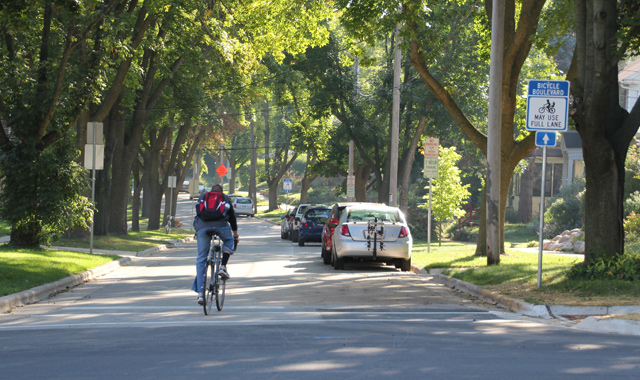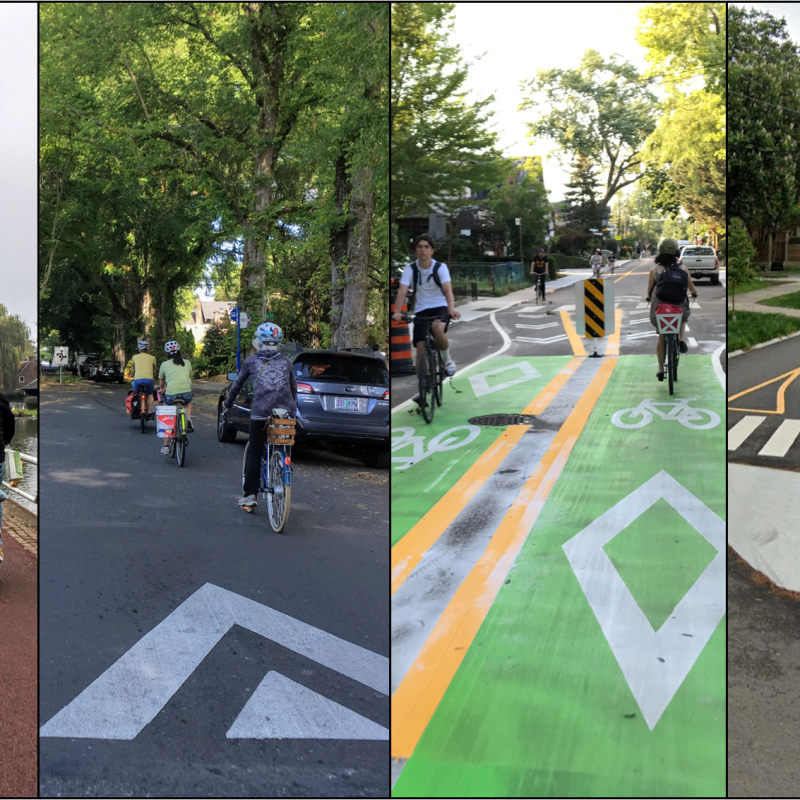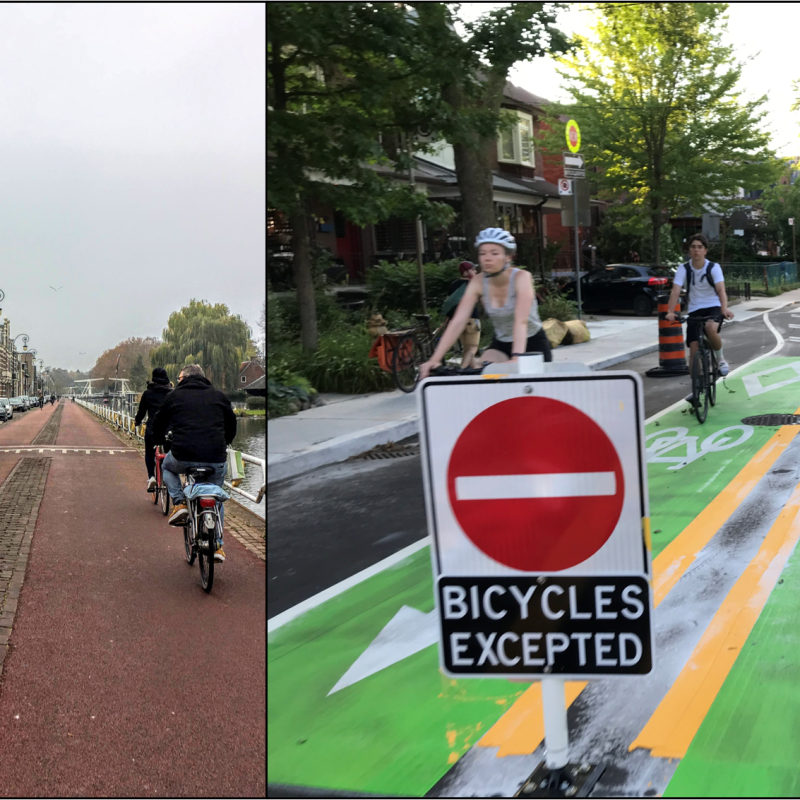Bicycle Streets Beyond Europe is a weekly multi-part series exploring the “bicycle street”. The first post overviewed the Dutch implementation of the bicycle street (“fietsstratten”) and the next several are showcasing some of the best examples of bicycle streets in Canada and the US. Special thanks to Justin Jones for contributing to this post. Join the Beyond the Automobile mailing list to stay up to date with the series.
While the “bicycle street” is on its way towards a consistent design approach in the Netherlands, in Canada and the US there is far from a consistent approach towards this concept.
In fact, even the approach to naming these streets varies significantly; “bicycle boulevards”, “local street bikeways”, “neighbourhood greenways”, and “slow streets” are all examples that apply some or all of the principles of a bicycle street. The name aside, however, the essence of a bicycle street or any permutation is that it re-prioritizes the users of the street, creating an environment where people riding bicycles are at the top of the road user hierarchy.
The rapid expansion of “Slow Streets” across North America during the COVID-19 Pandemic in 2020 has introduced a growing number of communities to the idea that not every street needs to operate with a mindset of automobile primacy. With this in mind, this series will showcase some of the best examples of bicycle streets in Canada and the US in hopes of establishing a more robust set of design and communications practices that can help to bring a more permanent “people first” streets orientation of our communities.
Before we review the streets that will be examined in this series, let’s first recap the fundamentals of what constitutes a “bicycle street” in the Dutch context from the last post:
- Network: street must be part of the main bicycle network, and serve only a local function for cars
- more bicycles than cars using the street, at least 1,000 bikes per day, and no more than 2,500 cars per day
- Speed: 30 km/h maximum operating speed, regulated through speed humps and raised intersections
- Design: narrow 4.5m travel surface, consisting of a 3.5m bidirectional cycle track or two 2.0m unidirectional cycle tracks plus edge surfacing
- Behaviour: The ultimate goal or outcome of a bicycle street is “bicycle dominance”, where cyclists hold the dominant position over motor vehicles, creating a riding experience free of the stress of a tailgating motorist or the pressure to move over or ride single file. All of the above conditions support but do not necessarily guarantee bicycle dominance, and this is very sensitive to the local context and the habits/attitudes of local users.

This post will review the “Bicycle Boulevard”, as discussed in NACTO guidance. We’ll then follow up this post with other case studies of bicycle streets in Canada and the US.
NACTO: The Bicycle Boulevard
The National Association of City Transportation Officials (NACTO) is one of the leading voices in the creation of safer streets across North America. The 2014 NACTO Urban Bikeway Design Guide defines bicycle boulevards as:
“Bicycle boulevards are streets with low motorized traffic volumes and speeds, designated and designed to give bicycle travel priority. Bicycle Boulevards use signs, pavement markings, and speed and volume management measures to discourage through trips by motor vehicles and create safe, convenient bicycle crossings of busy arterial streets.”
NACTO provides further design guidance in their 2017 Designing for All Ages and Abilities Guide by saying that:
“Bicycle Boulevards (or neighborhood greenways) provide continuous comfortable bicycle routes through the local street network. Bike Boulevards are characterized by slow motor vehicle speeds and low volumes. Sometimes these are present by the very nature of the street and its function (e.g. narrow streets with no major destinations), but sometimes design work is needed, such as adding traffic calming elements, filtering most motor vehicle traffic off, and/or prioritizing bicycles at major and minor street intersections. In this way, bicycling is made comfortable across the entire roadway.”
The 8 Design Elements of a Bicycle Boulevard, as defined by NACTO are:
- Route Planning: Direct access to destinations
- Signs and Pavement Markings: Easy to find and to follow
- Speed Management: Slow motor vehicle speeds
- Volume Management: Low or reduced motor vehicle volumes
- Minor Street Crossings: Minimal bicyclist delay
- Major Street Crossings: Safe and convenient crossings
- Offset Crossings: Clear and safe navigation
- Green Infrastructure: Enhancing environments

Importantly, NACTO emphasizes that bicycle boulevards may be appealing to other users, including residents and other people using active travel modes, who also benefit from the quieter environment and improved safety that this facility creates. We can draw a parallel here to one of the Dutch lessons learned in the last post: bicycle streets tend to receive more political support when routed through residential areas, because residents also benefit from bicycle streets, even if they do not cycle themselves.

Is it a Bicycle Street?
Is the NACTO bicycle boulevard a bicycle street? Let’s compare against the Dutch fundamentals listed above.
- Network: Bicycle boulevards are “a key component of a low-stress bikeway network”, and NACTO recommends creating routes that follow a “desire line for bicycle travel”, and minimize delay for people on bikes.
- Volumes: Motor vehicle volumes should be under 500-2,000 vehicles per day, and no more than 50 vehicles in the peak direction during the peak hour in order to ensure maximum comfort for people on bikes. Notably, there is no minimum volume for bicycle traffic.
- Speed: Operating speeds of 20-25 mph (30-40 km/h) are recommended, based on the 95th percentile operating speed. This means that it is recommended that design changes ensure that 95% of people driving are going 30-40 km/h or lower.
- Design: NACTO’s design guidance is not as specific as that from the CROW Manual. Indeed, there is little mention of prefered road width in the guidance. This allows designers to build Bicycle Boulevards that fit the local context – for example, by permitting parking on both sides of a wider residential street.
- Behaviour: NACTO’s guidance emphasizes the goal of giving bicyclists priority to ensure that “bicycling is made comfortable across the entire roadway”. While design alone cannot predict behaviour, the NACTO guidance encourages designers to add a sufficient level of traffic calming, traffic diversion, pavement markings and signage to ensure that people driving don’t see these routes as a viable route to travel any significant distance.
Many elements of the NACTO bicycle boulevard closely mirror the principles of a Dutch bicycle street, namely the focus on speed and volume management, providing a comprehensive network, and the stated goal of prioritizing bicyclists on the full width of the roadway. NACTO offers less strict guidance in terms of geometry and roadway width, but this can be seen as a strength as it leaves more room for designs to be developed that work best in the local context. NACTO also does not recommend a minimum volume of bicycle traffic to designate a bicycle boulevard; while the Dutch bicycle street was created to improve conditions for the many existing cyclists, NACTO instead aims to stimulate demand for new bicyclists in communities where base cycling rates may be very low.
It seems clear that NACTO’s design guidance, when applied comprehensively, would result in the creation of a facility that would look and feel very much like a bicycle street.
NACTO’s guidance captures one of the key challenges of a bicycle street: unlike a bike lane, which is recognizable and easily standardized, a bicycle street (or bicycle boulevard) represents a desired set of behaviours rather than a simple piece of infrastructure. This makes it hard to imagine, and from our experience, it makes much more sense after actually experiencing a well-built example. With this in mind, the next three posts will showcase real, constructed, tangible examples of the “bicycle street” concept in Canada and the US.

Special thanks to Justin Jones for collaborating on this post. Justin is an active transportation and community engagement professional who works to create communities where transportation is a joy, not a chore. He works to expand access to public spaces for everyone, regardless of how they choose to get around. You can find him on Twitter.
Don’t forget to check out the other posts in the Bicycle Streets Beyond Europe series below.









3 Comments